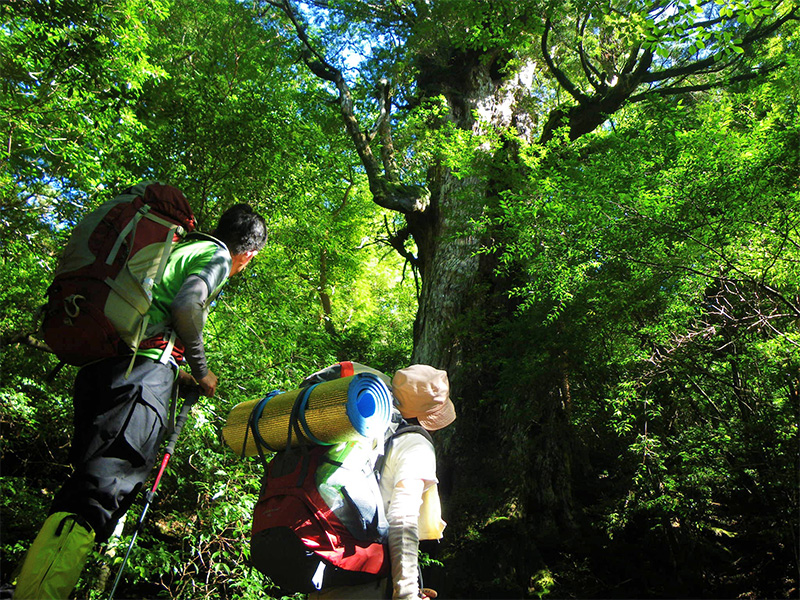Ecotourism Trekking to the Jomon-sugi Cedar
Trekking in a forest of Yakusugi Cedars more than one thousand years old.
From the Arakawa Trail Entrance, there are various trails to the Jomon-sugi Cedar after passing the Kosugidani and Kusukawa Junction. The Okabu Trail starts in the vicinity of the end of the railcar tracks passes the Jomon-sugi Cedar, and continues on to the Takatsuka Hut.
Some are also included in the World Heritage area, and in addition to the Jomon-sugi Cedar there are many other famous Yakusugi Cedars such as the Wilson-kabu Stump and the Daio-sugi Cedar, which together form the popular sightseeing trails for trekkers.
Following registration as a World Heritage site the number of Okabu Trail visitors increased rapidly, resulting in various problems including soil erosion, exposure of tree roots, destruction of plant life, and loss of vegetation due to visitors not staying on trails and using areas for rests. Use of the trails has a serious impact on the natural environment. There were also other issues related to maintenance and management of facilities such as overuse of toilets in the mountain area. Furthermore, concerns about a decline in the quality of the visitor experience, for example visitors no longer being able to experience the natural environment typical of Yakushima Island, grew due to concentrated use and overcrowding at certain times.

After peaking in 2008, the number of visitors trekking to the Jomon-sugi Cedar has trended downward, and the island has entered a transition period in utilization. A vision was established to achieve the goals of not only preserving and passing on to the next generation the natural environment of the mountain area, but also of providing visitors with a high-quality nature experience typical of Yakushima Island. Efforts are underway to promote use of facilities in mountain areas such as facility maintenance based on zoning, visitor guidance, and services.
State of use
- More than 90% of visitors are trekkers visiting the Jomon-sugi Cedar on day trips.
- The number of trekkers has averaged approximately 60,000 annually after peaking at 90,000 in 2008.
- Except during the off-season (December - February), there is a more-or-less constant flow of visitors all year round, and during major long holidays such as Golden Week numbers increase to approximately 800 per day.
Recent efforts
- 2008: Began transporting all sewage from mountain toilets (Takatsuka Hut) using Yakushima Mountain Area Preservation funds.
- 2009: Introduced portable toilets (visitors carry their own waste out) to reduce the volume of sewage in the mountain area.
- 2010: Introduced restrictions on use of cars up to the Arakawa Trail Entrance during the on-season (March - November) by using trekking buses departing from the Yakusugi Museum in order to preserve the natural environment and improve conditions for visitors.
- 2016 - 2021: Established the Yakushima Island Mountainous Area Appropriate Utilization Committee to protect the natural environment and provide a high-quality visitor experience. Established a 50-year vision for the Jomon-sugi Cedar route, and investigated measures to create the appropriate facilities and attract visitors.
- 2017: Launched the World Natural Heritage Yakushima Mountain Environment Conservation Donation Program with the goal of preserving the natural environment to provide visitors with a safe and secure natural experience.
Main changes and problems in use
1. Natural Environment
- Several problems have appeared as the number of visitors has increased, notably the destruction of vegetation near trails, loss of vegetation due to visitors passing each other while trekking, greater use of sites for rests, and visitors departing from trails due to ignorance of trail etiquette.
- There is evidence of visitors relieving themselves outdoors.
2. Conditions for Visitors
- Particularly when conditions are crowded, there is a long line of visitors waiting to view the Jomon-sugi Cedars and Wilson-kabu Stump. This and other problems undermine the solemn feel of the Yakusugi Cedar forest and detract from a pleasant environment for visitors.
- Under these conditions, there are also long lines for toilets, and the volume of sewage exceeds capacity and accumulates, resulting in bad odors and toilets breaking down.
3. Safety Management
- Due to greater media exposure and other reasons, many visitors are persuaded that the 20 km trek there and back to the Jomon-sugi Cedars is a simple task. A growing number of visitors have little awareness of safety, and are ill-equipped and do not allow sufficient time considering their physical condition, resulting in frequent emergencies.

